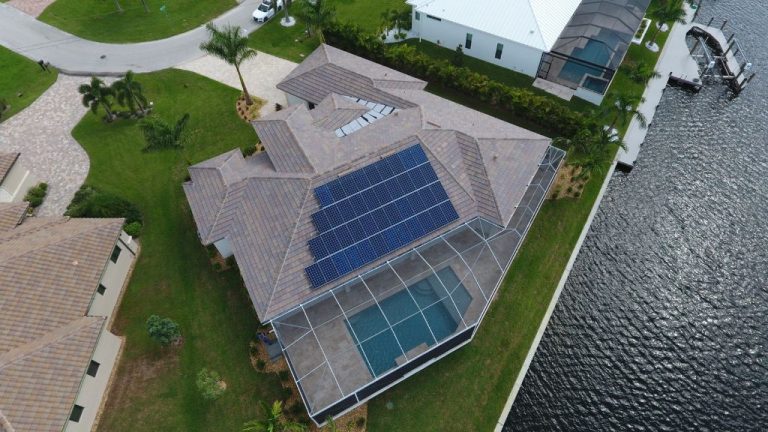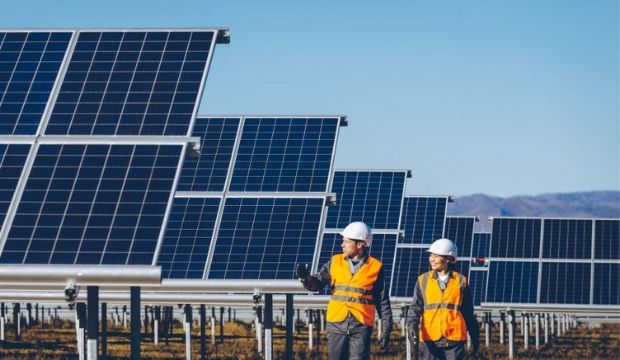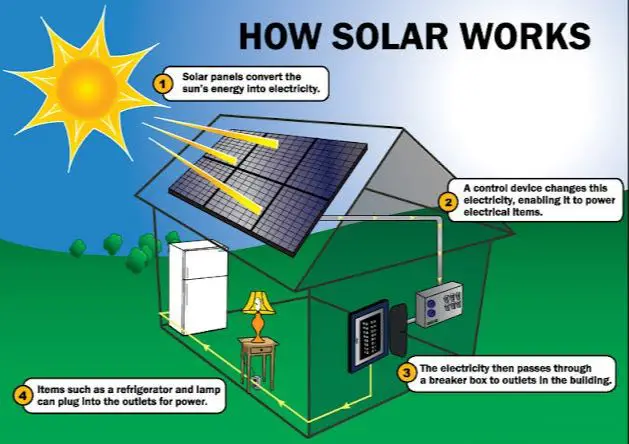What Is Solar Energy And Why Is It Renewable?
What is Solar Energy?
Solar energy is the radiant energy emitted from the sun, which is harnessed using a range of technologies like solar heating, photovoltaics, and solar thermal energy. The sun is a powerful energy source, and solar energy technologies allow us to harness its light and heat to generate electricity and provide heating/cooling.
There are two main ways solar energy is converted into electricity:
- Photovoltaic (PV) solar panels directly convert sunlight into electricity using semiconducting materials. When sunlight hits these materials, the solar energy excites electrons and causes them to flow, generating electric current.
- Concentrated solar power (CSP) systems use lenses or mirrors to focus large areas of sunlight onto a small area. The concentrated light is converted to heat which drives a steam turbine connected to an electrical generator.
Solar energy is considered a renewable energy source because it draws upon the nearly unlimited supply of the sun’s light and heat. As long as the sun continues to shine, solar radiation will be available to generate electricity and heat homes and businesses.
The Sun as an Energy Source
The Sun is the original source of nearly all energy on Earth. The nuclear fusion reactions that take place at the Sun’s core release tremendous amounts of energy in the form of electromagnetic radiation. This energy radiates outward in all directions in the form of photons or packets of light energy.
The Earth intercepts only a tiny fraction of this solar energy, approximately 1 part in 2.3 billion. Yet this is more than enough to meet humanity’s energy needs many times over. The rate at which solar energy reaches a unit area at the Earth’s surface is known as solar irradiation and is typically measured in watts per square meter.
Solar energy technologies capture the Sun’s radiation and convert it into useful forms of energy. Solar panels convert sunlight into electricity, while solar water heaters transform the Sun’s energy into thermal energy to heat water. Even plants perform photosynthesis by capturing solar photons and converting them into chemical energy.

Solar energy is considered renewable because the Sun’s output is virtually limitless from a human perspective, and will continue shining for billions of years into the future. As long as the Sun exists, solar radiation will provide an abundant renewable energy source.
Photovoltaic Solar Panels
Photovoltaic (PV) solar panels, also known as solar modules, are devices that convert sunlight directly into electricity. PV panels work through the photovoltaic effect, which causes certain materials to absorb photons from sunlight and release electrons. The PV cells that make up a solar panel are made from semiconducting materials, usually silicon.
When sunlight hits the solar panel, photons are absorbed by the PV cells. If the photon’s energy is high enough, electrons are knocked loose from the atoms in the cell. Metal conductors inside the PV cell collect the free electrons and transfer them to wires, producing electric current. An inverter is used to convert the DC current from the panel into AC current that can power lights, appliances, and electronics.
PV panel systems do not require water for cooling or to generate steam to drive turbines. This makes them well-suited for many applications and locations. Rooftop solar PV systems are becoming increasingly popular on homes, warehouses, and commercial buildings.
Concentrated Solar Power
Concentrated solar power (CSP) uses mirrors and lenses to concentrate the sun’s energy to drive traditional steam turbines or engines that create electricity. The mirrors or lenses focus sunlight onto a receiver that heats up a liquid or gas, which produces steam to power the generator.
There are several types of CSP systems:
- Parabolic trough systems use long, U-shaped mirrors to focus sunlight onto a pipe filled with fluid that runs along the focal line of the trough. The heated fluid transfers its thermal energy to produce steam.
- Power tower systems use a field of flat, movable mirrors (heliostats) to focus and concentrate sunlight onto a central receiver on top of a tower. The receiver contains a fluid that is heated to a high temperature.
- Parabolic dish systems use dish-shaped mirrors, shaped like a satellite dish, to focus and concentrate the sun’s energy onto a receiver at the focal point of the dish. The dish tracks the movement of the sun.
- Fresnel reflectors use long, thin segments of flat mirrors mounted at different angles to concentrate sunlight onto tubes through which fluid is pumped.
The concentrated sunlight heats the fluid to very high temperatures, which is used to produce steam to power a turbine and generator. CSP allows for thermal storage, allowing electricity to be produced even when the sun isn’t shining.
Solar Thermal Energy
Solar thermal energy harnesses the sun’s heat to provide hot water and space heating. Solar thermal collectors, such as flat plates and evacuated tubes, absorb sunlight and transfer the heat to a liquid like water or a heat transfer fluid. This heated liquid is then circulated through a system to provide hot water or space heating.
Solar hot water systems use solar thermal collectors and a storage tank to provide hot water for residential, commercial and industrial buildings. The system works by circulating cold water through the collectors, which heat it up. This hot water is then stored in an insulated storage tank until needed, such as for washing or bathing.
Solar space heating systems work similarly, but circulate the heated liquid from the solar collectors through radiators or underfloor heating systems to warm a building. Active solar heating systems have pumps and controls to circulate the liquid, while passive systems rely on gravity and the tendency for hot fluid to rise.
Solar thermal systems can lower water and space heating bills significantly. They are also an environmentally-friendly technology since they harness renewable solar energy rather than burning fossil fuels.
Passive Solar Heating and Lighting
Passive solar design takes advantage of natural energy flows to heat, cool, and light buildings without relying on mechanical systems. Proper building orientation, window placement, construction materials, and landscaping elements allow buildings to capture solar energy passively.
Orienting a building’s longest side to face within 30 degrees of true south maximizes solar gain in the winter. Overhangs, awnings, and deciduous trees shade windows in the summer when the sun is high but allow sunlight through when the sun is lower in winter. South-facing windows collect and store solar energy during the day, reducing heating costs.
Using thermal mass materials like concrete, stone, and tile floors and walls absorbs solar energy during the day and radiates heat at night. Strategically placed light shelves and skylights with reflective surfaces maximize daylighting while minimizing glare and overheating. Passive solar design can reduce a building’s heating and lighting costs by up to 85 percent compared to conventional buildings.
Solar Energy Storage
Solar energy can be stored for use when the sun is not shining through technologies like batteries and thermal energy storage.
Batteries are one of the most common ways to store solar energy. They store the electricity generated from solar panels during the day and discharge it for use at night. Lithium-ion batteries are often used for home solar energy storage. Utility-scale solar farms also utilize massive battery storage stations to capture excess solar power and feed it back into the grid as needed.
Thermal energy storage is another approach. This involves using solar heat to warm up materials like molten salt that can retain heat for extended periods. The stored heat can be used to generate steam to drive a turbine and produce electricity when needed, even at night. This allows solar thermal power plants to provide consistent clean energy 24/7.
Energy storage technologies are crucial for enabling wider adoption of solar power. They allow solar energy to be available on demand and provide stability to electrical grids that increasingly rely on renewable but intermittent energy sources like solar and wind.
Solar Energy Economics
The costs of solar energy have declined significantly in recent years, making it increasingly competitive with conventional energy sources. The main factors driving down costs include technological improvements, economies of scale in manufacturing, and streamlined installation processes. Many governments also provide incentives like tax credits and rebates to further reduce costs for homeowners and businesses.
Today, solar energy is cost competitive with fossil fuels and nuclear in many markets globally. In sunny regions, large-scale solar generation can produce electricity for 2-7 cents per kilowatt-hour, on par or below the cost of coal and gas plants. Rooftop solar for homes and businesses can also provide electricity for a similar or slightly higher cost than buying from the grid.
While solar does require high upfront investment, lifetime costs are low since the fuel (sunlight) is free. Any operation and maintenance costs are also minimal. And as panel technology continues improving, solar’s cost advantage over conventional fuels will likely widen.
Despite solar’s increasing cost competitiveness, some challenges remain. Storage is still expensive, making it harder for solar to provide 24/7 baseload power. Areas with fewer sunny days can also reduce solar output and value. But overall, as solar prices fall while fossil fuel and nuclear costs remain high or increase, solar is poised to keep expanding its energy market share.
Environmental Benefits
Solar energy has major environmental advantages over fossil fuels such as coal, oil and natural gas. Fossil fuels produce air and water pollution when burned to generate electricity. They also contribute to climate change by emitting large amounts of carbon dioxide, a greenhouse gas.
In contrast, solar energy generates electricity without air or water emissions. Solar panels produce clean, renewable electricity from sunlight without releasing any pollutants. Concentrated solar thermal plants use mirrors to focus sunlight to heat a fluid and drive a steam turbine. This process does not burn any fuels or emit greenhouse gases.
Widespread use of solar energy would significantly reduce air pollution and related health problems caused by burning fossil fuels. It would also help mitigate climate change by displacing carbon-intensive electricity generation. Solar energy could potentially supply a large fraction of the world’s electricity with little environmental impact.
Solar photovoltaic and concentrating solar power technologies provide a clean alternative for power generation. The development of solar energy helps combat global warming and improves public health by reducing harmful air pollution.
Why Solar Energy is Renewable
Solar energy is considered renewable because it comes from the sun, which is a virtually limitless source of energy. The amount of solar energy that reaches the Earth’s surface every hour is greater than the total amount of energy used by humans globally in an entire year. Unlike fossil fuels like coal, oil and natural gas, which are finite resources that will eventually be depleted, the sun is expected to continue providing consistent energy to the Earth for at least another 5 billion years.
The development of solar power is sustainable because it does not use up limited material resources and can continue generating clean, renewable electricity indefinitely. Once solar panels are installed, they can keep producing solar power with just occasional cleaning and maintenance. Fossil fuels, on the other hand, draw on finite reserves of non-renewable resources. Extracting and burning these finite resources causes damage to the environment through pollution and greenhouse gas emissions. Ultimately, fossil fuels will run out, making them unsustainable in the long term.
Solar energy’s renewability and abundance provide energy security for the future and protects against fuel shortages and price instability. With solar power, we can transition to a cleaner and more sustainable energy system based on harnessing the practically limitless power of the sun.






